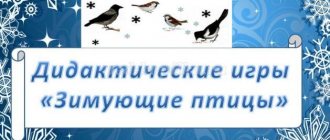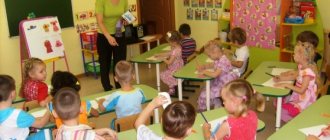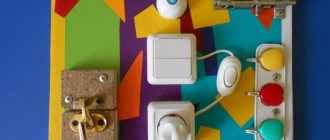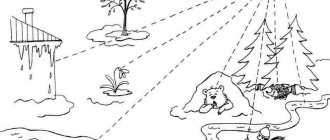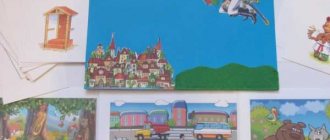Outdoor games
- Game "Who's Dressed in What." This game requires several participants. The presenter says: “Whoever is wearing a red T-shirt, sit down,” or “Whoever is wearing green pants, clap your hands.” The player whose color is named must perform the given actions.
- Round dance . The children dance in a circle, the adult says:
“Masha walked along the path, Masha found slippers. Masha tried on the slippers, put them on a little, and limped. Masha began to choose who to give the slippers to. Kolya’s slippers are good: “Here, put them on and dance.”
The shoes are given to the person whose name is named.
- Paths . We put several scarves on the floor - these were our paths. And they ran and jumped on them. We found a short-long path, wide-narrow.
Home clothes
Take clothes out of your closet. Lay it out in front of your child. Introduce your baby to the names: collar, sleeve, sleeves, pocket, pockets, button, buttons, zipper, hood. Tell your little one that there are outerwear and underwear. The upper one is so called because we wear it on top, the lower one – below, under clothes. Look at the pictures on the clothes, talk about what they are made of. Name the color of the clothes at the same time, count the sleeves, pockets, buttons. Tell your child what seasonal clothing is. Let him guess what time of year these clothes are worn (hat, jacket - in winter, cap, T-shirt - in summer).
Game "Suits"
Draw separately the details of the costume: blouses and skirts, T-shirts and shorts, jacket and trousers. The main thing is that the details of the costume are the same color, pattern, etc. (T-shirt with red polka dots and shorts are the same). Mix all the details. Ask your child to choose the right costumes. Start with 2-3 and gradually increase complexity.
Task 10. Let's smile together!
And in conclusion, I want to smile with you and suggest you read a funny story in which clothes play a leading role.
Show your child the picture. “Does this boy know how to dress himself? Why? What did he do wrong? What can happen to a boy or girl who doesn’t know how to dress themselves? Listen to the story about the boy who didn’t know how to dress himself.”
"Stupid story." M. Zoshchenko.
Petya was not such a little boy. He was four years old. But his mother considered him a very tiny child. She spoon-fed him, took him for walks by the hand, and dressed him herself in the morning.
One day Petya woke up in his bed. And his mother began to dress him. So she dressed him and put him on his legs near the bed. But Petya suddenly fell. Mom thought he was being naughty and put him back on his feet. But he fell again. Mom was surprised and placed it near the crib for the third time. But the child fell again.
Mom got scared and called dad at the service on the phone. She told dad: “Come home quickly.” Something happened to our boy - he can’t stand on his legs. So dad comes and says: “This is nonsense.” Our boy walks and runs well, and it is impossible for him to fall. And he immediately puts the boy on the carpet. The boy wants to go to his toys, but again, for the fourth time, he falls. Dad says: “We need to call the doctor quickly.” Our boy must have fallen ill. He probably ate too much candy yesterday. The doctor was called. A doctor comes in with glasses and a pipe. The doctor says to Petya: “What news is this!” Why are you falling? Petya says: “I don’t know why, but I’m falling a little.” The doctor says to the mother: “Come on, undress this child, I’ll examine him now.” Mom undressed Petya, and the doctor began to listen to him. The doctor listened to him through the tube and said: “The child is completely healthy.” And it’s surprising why it falls for you. Come on, put him on again and put him on his feet. So the mother quickly dresses the boy and puts him on the floor. And the doctor puts glasses on his nose to better see how the boy falls. As soon as they put the boy on his feet, he suddenly fell again. The doctor was surprised and said: “Call the professor.” Maybe the professor will figure out why this child is falling. Dad went to call the professor, and at that moment a little boy Kolya comes to visit Petya. Kolya looked at Petya, laughed and said: “And I know why Petya falls.” The doctor says: “Look, what a learned little fellow they have found, he knows better than me why children fall.” Kolya says: “Look how Petya is dressed.” One of his trouser legs is dangling, and both legs are stuck in the other. That's why he falls. Here everyone oohed and groaned. Petya says: “It was my mother who dressed me.” The doctor says: “You don’t need to call the professor.” Now we understand why the child falls. Mom says: “In the morning I was in a hurry to cook porridge for him, but now I was very worried, and that’s why I put his pants on so wrong.” Kolya says: “But I always dress myself, and such stupid things don’t happen to my legs.” Adults always get things wrong. Petya says: “Now I’ll dress myself too.” Then everyone laughed. And the doctor laughed. He said goodbye to everyone, and he also said goodbye to Kolya. And he went about his business. Dad went to work. Mom went to the kitchen. And Kolya and Petya remained in the room. And they started playing with toys. And the next day Petya put on his pants himself, and no more stupid stories happened to him.
And here’s another joke from St. Petersburg – also about clothes. Send your funny jokes to the competition “Mixies on the Native Path”.
Game "Find a Pair"
Get out the different shoes you have in your house. Lay them out on the floor and ask your child to find the pairs. If your child easily copes with the task, sort the shoes - with laces, with a lock, with a buckle, etc.
Another version of the game is to lay out the socks in front of the baby and invite him to find the pairs. A little later, add mom’s socks, let the child not only sort them into pairs, but also separate the small ones from the large ones.
Talk to your child about what else comes in pairs: arms, legs, ears, glasses, etc.
Task 9. Let's play! Finger gymnastics
Invite your child to imitate how his mother (or grandmother) sews (put three fingers in a pinch, as if they were holding a needle and thread and smoothly move your hand up and down) and read him the words of the song.
Needle, needle, You are sharp and prickly. Don’t prick my finger, Shay sarafan (Russian folk song)
Repeat the words of this folk song with your child, pretending to sew. First, repeat the song slowly (the needle sews slowly), then faster, then very quickly (the pace of hand actions also speeds up), then slowly again. In this way, we teach the child to consciously change the tempo of speech.
Logic games:
- Separate the mittens from the gloves.
- We sort clothes according to the principle: large, small, medium (we select trousers for the doll from three options).
- We sort according to the principle: long, medium, short (scarf).
- Game "What's extra?" — (jacket, skirt, sweater and scissors).
- Game "Continue the Row"
- Game “Connecters” (we draw pairs of clothes, the child’s task is to connect the same ones with each other).
- Puzzles – draw clothes, cut them into 3-4 pieces and you’re done.
- We count the number of things in the bags (we draw several bags, “fill” each one, invite the child to put the numbers into the bags).
- We are looking for shades for clothes.
- Game "Singular and Plural". Call the child the object in the singular, and he in the plural. For example: shoe - boots.
- Game "What's missing?" Place clothes or shoes in front of the baby. Take one away - what's missing? Another option is to swap shoes - what has changed?
- Game "What's Hidden" Take several hats and hide any object or toy under one of them. Let the baby try to guess where she is.
Task 4. Guess where the mistake is in this poem about clothes.
In the summer, during hot hours - Only a T-shirt and shorts. And in winter we need: Sweater, warm pants, Scarf, coat, sandals, Hat and so on. Hat..., sweater... However, I... I'm confused, friends! A. Shibaev
Read this poem to your child and ask him to find the mistake. What clothes do we need in summer? What about in winter?
- “And in winter we need a sweater, warm pants, scarf, coat, sandals, hat, and so on.” What's wrong here? What's not clothes here? (Sandals are summer footwear, not winter wear)
Preview:
Goals:
Expand children's knowledge about clothing. Enrich children's vocabulary on the topic. Teach children to classify clothes according to a given criterion (winter or summer, women's or men's). Reinforce the concepts of color, size, shape, quantity. Develop thinking, attention, fine motor skills.
Equipment:
Cut-out pictures depicting various clothes. (for convenience and durability, we have them laminated with tape), a box with clothespins, images of a boy and a girl, cardboard strips of different colors (blue, yellow, pink, red, green). Progress of the game:
Option 1: “Name the clothes and their details”
The teacher asks you to select one item of clothing from the box and name the details (collar, pocket, hood, buttons, etc.)
Option 2 “Clothes for boys and girls”
The mother washed her son and daughter's clothes and asked them to carefully hang their clothes to dry using clothespins. Show your son, daughter. Girls' clothes should be hung on pink stripes, boys' clothes should be hung on blue stripes. Help children hang their clothes correctly.
Option 3 “Seasonal clothes”
Let's use clothespins to attach clothes that can be worn in summer (winter, spring, autumn) to colored stripes.
Attach winter clothes to the blue stripe, summer clothes to the red stripe, autumn clothes to the yellow stripe, and spring clothes to the green stripe. For each strip from one to three items of clothing. How many did you get on your strip of clothing? Who is this clothing for - a boy or a girl? What colour?
Didactic game "Clothes"
Didactic game “Number. Sign. Subject" on the lexical topic "Clothing"
The game is intended for children aged 4-6 years with severe speech impairments, as well as for children of preschool and primary school age to develop the lexical and grammatical structure of speech.
Didactic game “Number. Sign. Subject" can be used both in individual and subgroup lessons with children.
Target:
This set of games will help an adult teach a child:
- agree nouns with numerals and adjectives in gender, number, case;
- select qualitative, relative, possessive adjectives for nouns;
- use ordinal numbers in speech, coordinate them with nouns and adjectives in gender, number, case;
- activate mental activity, associative thinking;
- make comparative sentences with the conjunction “a”.
Material for the game:
cards with game tasks in two subjects of the same lexical group; playing field and cut cards for independent selection and compilation of a plot series; sets of numbers.
Game description:
Game with ready-made models: each table contains tasks for two subjects of the same lexical group for a larger educational load. At the beginning of the game, the child needs to be clearly shown how associations can be used to indicate the characteristics of objects. For example, how can you depict a bitter taste, show the hardness, softness, juiciness of vegetables, color and shape.
Below are ready-made game cards:
- one red sports jacket;
- three green warm jackets;
- two yellow fabric dresses;
- five blue wool dresses;
- two blue short skirts;
- six orange long skirts;
- three gray winter fur hats;
- seven red summer cloth caps;
- four black men's socks;
- eight pink children's knitted socks;
- one pink women's sports jacket;
- five purple children's knitted sweaters;
- two blue fabric trousers;
- one red cloth shorts;
- seven black women's fur coats;
- one red fabric women's coat.
The game requires compliance with the following steps:
- Name a word denoting a number (what number? - seven).
- Name the word denoting the object (what is this? - fur coat).
- Agree the noun with the numeral in gender, number (how many fur coats? - seven fur coats).
- Name the words denoting the attribute of an object, coordinate them with numerals and nouns in gender, number (seven fur coats (which ones?) - black, fur, women's).
- Agree the numeral with the adjectives and noun in gender, number (Say in a complete sentence, starting with the number. – Seven black women’s fur coats.)
- Using the same principle, consider another item of the lexical group - coat.
- Make comparative sentences with the conjunction “a”. (There are seven fur coats, and one coat. The fur coat is black, and the coat is red.)
Game with cut cards : played on the same principle as with ready-made models. Only here the child takes an active position and is given more independence.
First, you should invite the child to choose an item on a lexical topic and place it in a sector with an asterisk, then a number (place in the first sector) and select adjectives in the form of picture symbols (place in the longest sector of the playing field). The symbol pictures are first reviewed and what they mean is explained.
To better understand the progress of the game with cut cards, a sample is provided below.
Using the didactic game “Number. Sign. Subject" children will quickly master the skills of agreeing adjectives, nouns and numerals in gender, number, case; will learn to select adjectives for nouns and develop their associative thinking.
The development of associative thinking has a positive effect on the process of memorizing and reproducing necessary information.
On our website you can find other educational games from the “Number” series. Sign. Item". To do this, follow the highlighted link .
We wish everyone success.
Task 2. What are clothes? Let's find out the general word "clothing"
Look at the picture. These are the things that Tanya really likes to wear. What is this? (dress skirt).
You will see what Vanya likes to wear in the next picture. What is this? (shorts, trousers, shirt)
How are all these things similar?
(Prompt your child with a question - “Why do we need a dress, trousers, shorts, shirt, skirt? Yes, we wear them, put them on. This means they are similar in that we put them on ourselves.”) The things we wear, we put on ourselves
are called clothes.
Why do we need clothes? Reason with your child.
- Clothing protects us from the cold. We would freeze in winter without a fur coat or coat.
- And in the summer, clothes protect us from the heat and the sun.
- Clothing also protects us from mosquitoes and midges so that they don’t bite. They will sit on our clothes, but they cannot bite us.
- Clothes are also needed for beauty. Beautiful clothes give us a good mood.
Ask your child what clothes he has. Does he have any favorite clothes?
What clothes does mom have? What about dad? A brother or sister? Look at the clothes you have at home and name the details of the clothing - cuffs, pockets, buttons, zippers, collars, sleeves, buttons. For example: “What is this? Cuffs. What other clothes have cuffs? Do the mittens have cuffs? And on the jacket?
How to make cards and pictures of clothes for children
The presented clothing pictures need to be downloaded and printed, if you want to paste them onto cardboard or other thick paper. Cut out the cards and show them to your child in a playful way.
You can play with one child or in a group of children. In this case, tasks for children may be different:
1) name the objects correctly;
2) tell what you can wear with what;
3) which of the items belong to men’s clothing and which to women’s;
4) what is worn in winter, spring, summer, autumn.
The most important thing in communicating with a child is, undoubtedly, the positive attitude of an adult, then learning will be easy and beneficial for the child.
Educational games for children are very different. Children playing educational games train their own thinking, ingenuity, imagination, and creativity.
Task 1. Learn to compare, observe, describe objects
Look at the pictures. This is brother and sister. Their names are Tanya and Vanya. See how they smile in the picture. They are glad to meet you!
Yesterday mom and dad bought new winter clothes for Tanya and Vanya. After all, it will soon be winter, it will become very cold, and you will only be able to walk outside in warm clothes. Look at the picture - these are the clothes that were bought for Tanya. What is this?
How are fur coats
and
a coat
? (The fur coat is made of fur, it is fur, and the coat is made of fabric). How are they similar? (They are warm; we wear both a fur coat and a coat in winter; they have sleeves, buttons, pockets, and a collar).
Guess the riddle: “Fluffy, not snow. It’s heating, not the stove.” What is this? (Fur coat). Why do you say that? (The fur coat is fluffy, it warms, it is very warm).
Guess my riddle. What did I wish for – a fur coat or a coat?
“These are clothes for winter—winter. She is very warm. She has a large hood and long sleeves. It has no pockets. It is made of fur. What is this?" (Fur coat). Well done! Now tell me a riddle. “These clothes... It has... and... It's made of... What is it?” (Help your child describe a fur coat or coat by giving him the beginnings of phrases and suggesting individual words). Be sure to praise the child: “What a wonderful riddle you have created,” write down the riddle and tell it to the child’s dad, grandmother, and friends.
And for Vanya, mom and dad bought other winter clothes. Show your child a picture of Vanya's new clothes. What is this? (Jacket and overalls). How are they similar? (they are warm, winter; they have sleeves, buttons on the fastener, pockets, a hood with fur). What is the difference? (The jacket is short and the overalls are long. The overalls fit over the legs and have legs, but the jacket does not. They are different colors. The jacket is black, and the overalls are blue and brown)
Guess what Vanya liked more - the jacket or the overalls - “These are winter clothes. It has a hood with fur, button closures, and many pockets. It is black. It's short. What is this?"
